1.The Dust of Snow
- Books Name
- Online English tutor English Book
- Publication
- Online English tutor
- Course
- CBSE Class 10
- Subject
- English
Dust of Snow
By Robert Frost
Introduction
The poem “Dust of Snow” by Robert Frost illustrates a deeper sense. It explains how little and unimportant things can make our day happy.
Robert Frost (1874–1963) was an American poet who depicted realistic New England life through language and situations familiar to the common man. He won four Pulitzer Prizes for his work and spoke at John F. Kennedy's 1961 inauguration. Famous works include “Fire and Ice,” “Mending Wall,” “Birches,” “Out Out,” “Nothing Gold Can Stay” and “Home Burial.” His 1916 poem, "The Road Not Taken,"
Theme
In the poem "The Dust of Snow" Robert Frost talks about the importance of small things in our lives. These unexpected things happen in life and they bring their own effects and impacts. Even things of bad omen can be the reasons behind causing good things in your life. The poem shows the healing nature of the nature. The poet goes against the established traditional followings and sayings by depicting the symbols of bad omen crow and the hemlock tree as the reasons behind bringing a change of mood of the poet from gloom and hopelessness to optimism
Explanation
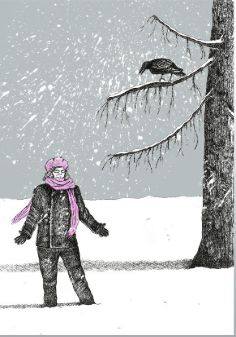
The way a crow
Shook down on me
The dust of snow
From a hemlock tree
Word meanings
Shook- shake
Hemlock- a poisonous tree with small white flowers
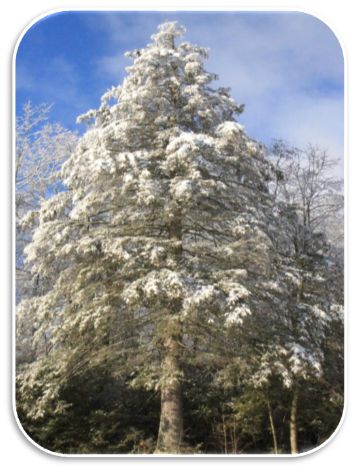
The poem sets in woods where the poet walking by a tree is in a bad mood and is walking by a tree, a hemlock tree, a poisonous one considered bad for luck . Suddenly a crow shooked as a result a dust of snow fell upon him.
Has given my heart
A change of mood
And saved some part
Of a day I had rued.
Rued- held in regret
The author was not in a good mood but the falling of the snow on his head lifted his mood instantly. Thus, rest of it was saved by the crow and the hemlock tree.
Generally, hemlock tree and crow are considered a carrier of bad luck but in this poem they are used as a mean of happiness and joy. The poet has portrayed the power of nature which can make anyone free from tension with its little and simple things.
Dust of Snow Literary Devices
- Rhyme Scheme- abab cdcd
- Alliteration- the occurrence of the same letter or sound at the beginning of adjacent or closely connected words.
The instances of alliteration are as follows-
- Has given my heart
- And saved some part
- inversion – when the structure of a sentence is changed by the poet to create rhyme, this poetic license is called inversion. In stanza 1, inversion can be seen.
- assonance – the prominence of a vowel sound throughout a line is called assonance. In stanza 1, line 2 – “Shook down on me” – ‘o’ sound is prominent.
- enjambment – when the same sentence continues to the next line without the use of any punctuation marks, it is called enjambment. It has been used throughout the poem.
Dust of Snow Summary
The short poem by Robert Frost depicts the incredible healing power of nature through its tiny things.
It’s beauty of the smallest thing that provide instant energy and can soothe our mind to get free from sorrow and grief.
The poem starts with poet saying that he had a bad experience since morning .
While he was passing through woods,
He happened to cross the path by hemlock tree ( considered as a carrier of bad luck) when suddenly due to the movement of the crow snow dust from the tree fell upon him.
The beauty of snow dust gave him instant joy that he forgot all his worries and sorrows.
In this way the rest part of his day got saved from getting sad .
Thus, he realised the power of nature and how petty his problem was.
The fact that hemlock tree is poisonous combined with crow being the indicator of doom and fear are used in the poem as the carriers of happiness in the life of narrator is ironical.
Through this poem the poet has also tried to depicts that the creature which are considered
Carriers of doom can bring joy.
It is just prejudice through which we
Believe something bad and relate them with bad luck.
Dust of Snow Question Answers
Q1. What is a “dust of snow”? What does the poet say has changed his mood? How has the poet’s mood changed?
Answer. The tiny particles of snow that resembles as dust together is called dust of snow.
The poet was in gloomy mood since the very beginning of the day. In his sorrow and dismay he was passing by the hemlock trees in woods, where suddenly due to the movement of the crow the dust fell on him and he got delighted with the beauty of snow dust.
In this way his mood got changed.
Q 2. How does Frost present nature in this poem? The following questions may help you to think of an answer.
(i) What are the birds that are usually named in poems? Do you think a crow is often mentioned in poems? What images come to your mind when you think of a crow?
Answer. Birds like sparrow, nightingale and peacock are more than often named in poems. Unlike these birds, crows are often seen as the indicators of doom and fear. They are often used for negative references.
(ii) Again, what is “a hemlock tree”? Why doesn’t the poet write about a more ‘beautiful’ tree such as a maple, or an oak, or a pine?
Answer. The poet has used hemlock tree to illustrate that those entities which are used for negative references and Believed to be a carrier of bad luck may also bring out joy in life.
Hemlock is considered as a source of badluck as it is poisonous. However, in the it has become the mean of joy for poet.
(iii) What do the ‘crow’ and ‘hemlock’ represent — joy or sorrow? What does the dust of snow that the crow shakes off a hemlock tree stand for?
Answer. Crow and the hemlock tree represent sorrow. However, they both have changed the mood of poet from sorrow to joy. Through this poem, the poet wants to change the preconceived notions about some typical things, that are just based upon thoughts.
The dust of snow stands for joy
2.Fire And Ice
- Books Name
- Online English tutor English Book
- Publication
- Online English tutor
- Course
- CBSE Class 10
- Subject
- English
Fire and ice
By Robert Frost
Summary
In this poem “Fire and Ice” Robert Frost has used fire and ice as a symbol of human emotion of desire and hatred.
He has illustrated the notion of two groups towards the cause of the destruction of whole world.
According to the one opinion that fire alone can destroy each and every possibility of life on Earth while the other thinks that if ice as a result of extremely low temperatures could cover the earth’s surface, it would lead to the end of the world.
Both the components has been compared with self-destructing human emotions: desire and hatred.
Initially, the poet favours the opinion that is associated with the fire or “fiery desires” and considers it is more capable of bringing human beings on the verge of destruction.
However, further in the poem he thinks that ice or hatred is equally capable of ruining humans, though slowly and steadily.
Therefore, if Earth was to end twice, ice would be just as good as fire.
Thus, the poet has put forth his philosophy that uncontrolled emotions whether it is hatred or passions desire would equally lead us to chaos just as fire and ice can bring earth on the verge of destruction.
Explanation

Some say the world will end in fire
Some say in ice.
From what I’ve tasted of desire
I hold with those who favour fire.
Word meanings
- Desire- a strong feeling of wanting to have something or wishing for something to happen
- Favour- approval, support
The poet depicts general idea that there are two ways, fire and ice through which the whole world could end.
According to the opinion of some people fire would be the reason of destruction if the earth’s core would get that much heated up that the surface would set in fire. However, according to the perception of others, due to excessive cold the environment would become too harsh to survive that one day life on Earth would become impossible.
The poet then compares fire and ice with the destructive features of human emotions; desire and hatred.
He says that he favours those who says that fire would end the earth as uncontrolled and unending desires would certainly be a cause of destruction of earth one day.
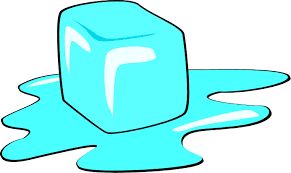
But if it had to perish twice,
I think I know enough of hate
To say that for destruction ice
Is also great
And would suffice.
Word meanings
- Perish- die
- Suffice- be sufficient
Then by being firm with the first option of fire, he considers if the world has to destroy twice, ice would be equally destructive in ending the earth.
He compares “ice” as “hatred” in terms of human disconcert and insensitivity that has the potential for inner destruction. Hatred, Though slow and steady, has the same effect that desire has on us. So if given an option between fire and ice, ice would be just as good as fire to destroy the world.
Literary devices
1.Assonance- it is repetition of vowel sounds in same line. The repetition is at different places in different words.
Example- The long sound of “o” in “I hold with those who favour fire”
2. Alliteration- alliteration is the repetition of a consonant sound at the start of two or more closely placed words.
Example- The sound of “f” in “favour fire”, “w” in “world will”
3. Imagery- Imagery is used to make readers perceive things involving their five senses. Example- “Some say the world will end in fire”
“To say that for destruction ice Is also great”
4. Anaphora- the repetition of a word or expression at the start of two or more consecutive lines.
Example – “Some say” is repeated at the start of lines 1 and 2.
5. Personification- Personification is to give human qualities to inanimate objects. In this poem, “fire” and “ice” are capable of destruction. Thus, the poet personifies fire and ice by giving them mind and power to destroy anything.
6. Enjambment- it is defined as the thought or clause that does not come to an end at a line break, rather it moves over to the next line.
Example- “From what I’ve tasted of desire
I hold with those who favor fire”
Fire and Ice Question Answers
1. There are many ideas about how the world will ‘end’. Do you think the world will end some day? Have you ever thought what would happen if the sun got so hot that it ‘burst’, or grew colder and colder?
Answer. Unfortunately, the world is going to end one day and there is nothing we can do about it. There are many ideas as to how it will end but one can’t say surely. The reason that life exists only on Earth is that the circumstances and temperature is apt to make it possible. If the sun gets so hot one day that it is at the verge of bursting, it would lead to rapid destruction as there would be fire everywhere. Conversely, if it grows colder and colder, there will be ice everywhere on Earth and life in any form would not be able to sustain at such low temperatures.
2. For Frost, what do ‘fire’ and ‘ice’ stand for?
Here are some ideas:
- greed
- avarice
- cruelty
- lust
- conflict
- fury
- intolerance
- rigidity
- insensitivity
- coldness
- indifference
- hatred
Answer. According to Frost, ‘fire’ stands for greed, conflict, fury, cruelty, lust and avarice whereas ‘Ice’ stands for insensitivity, coldness, intolerance, indifference, rigidity and hatred.
3. What is the rhyme scheme of the poem? How does it help in bringing out the contrasting ideas in the poem?
Answer. The rhyme scheme of the poem is “aba abc bcb”. The poet has used the rhyming beautifully to bring about contrasting ideas in the poem. He has used the ideas of two groups who believe that the world would come to a catastrophic end either as a result of fire or ice. Simultaneously, he portrays these two essential components as features of destructive human emotions: desire and hatred. Just like fiery desires and icy hatred can cause damage to an individual in an irreparable manner, fire and ice can lead the world at the verge of chaos and thus, apocalypse.
3.A Tiger in The Zoo
- Books Name
- Online English tutor English Book
- Publication
- Online English tutor
- Course
- CBSE Class 10
- Subject
- English
Tiger in the Zoo
By George Leslie Norris
About the Poet
George Leslie Norris (1921-2006) was a Welsh poet and short story writer. His literary works have won many prizes. His famous works are Finding Gold, The loud winder, phoenix living poets series: Ransoms, etc.

Summary
‘This poem has put put forth the plight of tiger by comparing between a tiger in the zoo with the tiger in its natural habitat.
The poem highlights a contrast in the mood and environment of a tiger when he is in the zoo and a tiger when he is in the forest.
In the zoo, a tiger is tamed and thus looses his freedom and respect as a ferocious and powerful king of animals.
In a cemented cell behind the bars he feels angry, frustrated and helpless. And long for his natural habitat, his entity of being a terror for villagers.
In the zoo, he is helpless and a showpiece or source of entertainment to people.
The poet wants to convey that it is cruel to keep wild animals in small enclosures of the zoo, away from their natural habitat. They feel angry, helpless and unhappy in the cage. To overcome his sorrow and plight he stares at the brilliant stars with his bright eyes, in the silence of night.
Explanation
He stalks in his vivid stripes
The few steps of his cage,
On pads of velvet quiet,
In his quiet rage.
Word meanings
- Stalks: follows
- Vivid: bright coloured
- Pads: paws of tiger
- Rage: anger
the poet says tiger in the zoo that is confined behind the bars moves around in the cage under his bright coloured skin.
He can take only a few steps as the cage iis too small and it is not easy to move in it. His footsteps are inaudible as he has very soft feet, like velvet. Since he is not free, he is controlling his anger by quietly walking in the limited area of his cage.
Literary devices
- Rhyme scheme: abcb (cage-rage)
- Personification: The tiger is personified because the poet refers him as ‘he’.
- Metaphor: Tiger’s paws are compared with velvet (pads of velvet)
- Enjambment: Sentence is continuing to next line without any punctuation mark.
- Imagery: poet tries to create an image about the tiger (He stalks in his vivid stripes The few steps of his cage)
- Consonance: use of ‘s’ sound (stalks, his, stripes)
- Assonance: use of vowel sound ‘I’ (in his vivid stripes)
- Oxymoron: use of adjectives opposite in meaning (quiet rage)
He should be lurking in shadow,
Sliding through long grass
Near the water hole
Where plump deer pass.
- Lurking: To be hidden as to wait for your prey
The poet says that instead of being in the cage he should be prowling behind the long grasses waiting for his prey as his actual habitat is forest.
Literary devices
- Rhyme: rhyme scheme is abcb (grass-pass)
- Enjambment: Line continues to next line without punctuation marks. (Sliding through….deer pass)
- Alliteration: use of sound ‘p’ at the start of two words (plump pass)
- Imagery: The poet has tries to create an image of tiger’s activities (lurking in shadow).
He should be snarling around houses
At the jungle’s edge,
Baring his white fangs, his claws,
Terrorising the village!
Word meanings
Snarling: warning sounds made by animals
Baring: uncovered
Fangs: Sharp tooth of animals
The poet says that if the tiger would have been free, he would have been terrorizing the villagers living beside the forest, by his sharp teeth and claws.
Being free he would have been an actual ferocious tiger for humans instead of a piece of entertainment.
A Tiger in the Zoo Literary devices
- Rhyme Scheme: abcb rhyme scheme is followed (edge, village)
- Enjambment: Line continues to next line without punctuation marks (He should be snarling around houses At the jungle’s edge,)
- Onomatopoeia: using words which denote sound (snarling)
- Assonance: use of vowel sound ‘o’ and ‘I’ (should, around, houses), (Baring, his, white, his)
- Consonance: use of consonant sound ‘s’ (his, fangs, his, claws)
But he’s locked in a concrete cell,
His strength behind bars,
Stalking the length of his cage,
Ignoring visitors.
- Concrete: building made of bricks, cement, sand and water
The poet illustrates the real sad condition of the tiger that it is confined in a strong cell which is made of strong building material.
He further says that as the tiger is confined in the bars, his power and ferociousness are also confined.
He just stalks in the cage. He never tries to terrorise the visitors as he is aware about his limitations that in the cage his ferociousness is of no use, nobody is going to be terrorise. Therefore, he never tries to terrorise the visitors as he cannot attack them.
Literary devices
- Rhyme Scheme: abcb rhyme scheme is followed (bars-visitors)
- Personification: The tiger is personified because the poet refers him as ‘he’.
- Assonance: use of vowel sound ‘e’ (he, locked, concrete, cell)
- Consonance: use of consonant sound ‘s’ (his, strength, bars)
- Alliteration: use of sound ‘b’ at the start of two words (behind bars)
He hears the last voice at night,
The patrolling cars,
And stares with his brilliant eyes
At the brilliant stars.
Word meanings
Patrolling: to guard, to vigil
The poet says that in the night, the tiger hears the sounds of the patrolling cars then stares at the shining stars with his shining eyes. The poet wants to convey the fact that the tiger is sad and as he is confined in the cage, so, he cannot do anything. Therefore, he stares at the stars in the night and tries to divert his thoughts towards them.
Literary devices:
- Rhyme Scheme: abcb rhyme scheme is followed (cars-stars)
- Enjambment: Line three continues to line four without any punctuation mark. (And stares with his brilliant eyes At the brilliant stars.)
- Alliteration: use of sound ‘h’ in the starting of two words (he hears)
- Assonance: use of ‘I’ sound (with, his, brilliant)
Question Answers
Q1- Read the poem again, and work in pairs or groups to do the following tasks.
(i) Find the words that describe the movements and actions of the tiger in the cage and in the wild. Arrange them in two columns.
(ii) Find the words that describe the two places, and arrange them in two columns.
Now try to share ideas about how the poet uses words and images to contrast the two situations.
Answer-
(1)
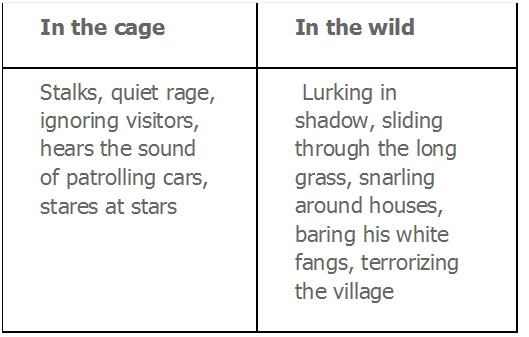
(2)
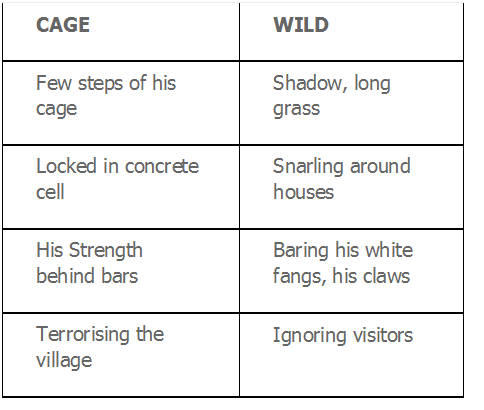
Q2- Notice the use of a word repeated in lines such as these:
(i) On pads of velvet quiet, In his quiet rage.
(ii) And stares with his brilliant eyes At the brilliant stars.
What do you think is the effect of this repetition?
Answer- The poet has repeated the words to emphasize that the tiger has to walk in the limited area of his cage. He cannot run as he would have done had it been in the forest.
Whereas ‘quiet rage’ phrase is used to illustrate his hidden anger due of his confinement in the cage. R
The next word he used is ‘brilliant’. The word brilliant in the first line means the twinkling bright stars and the brilliant words used for the tiger’s eyes shows the sadness of the tiger who would have led a free and fearless life if it were in the jungle.
5.The Ball Poem
- Books Name
- Online English tutor English Book
- Publication
- Online English tutor
- Course
- CBSE Class 10
- Subject
- English
The Ball Poem
by John Berryman

About the Poet
John Berryman was an American poet and scholar. He is best known for the Dream Songs (1969) which was a sequence of 385 poems. He won Pulitzer Prize for the dream songs. He also won the National book award
Summary
In this poem the poet is trying to illustrate that one must learn how to bear loss which is certain reality of life, by describing a boy who has lost his ball.
A boy has lost his ball while playing when it bounces out of his control and finally falls into the water. Consequently, the boy became sad.
The poet feels his sorrow that how his memories were attached to that ball that no other ball will be sufficient to lessen his sadness. Here, the lost ball is metaphorically used to convey general loss of a human being that can be the loss of personal possession, the death of some near and dear one.
The poet has conveyed the beautiful lesson that everyone has to bear losses throughout his life, he must learn how to face the sorrow and move on in life.
The Ball Poem Introduction
The poet John Berryman through his poem, ‘The ball poem’ has described the reality of life which everyone has to face one day. He has touched the topic of how to stand up against the miseries and sorrows of life.
Explanation
What is the boy now, who has lost his ball,
What, what is he to do? I saw it go
Merrily bouncing, down the street, and then
Merrily over — there it is in the water!
1. Merrily: cheerful
2. Bouncing: jumping up and down
The poet is depicting the sad moments of a boy who has lost his ball. He is trying to find out what this boy will do after losing his ball.
The poet has seen the ball going away from the boy, merrily jumping up and down in the street and finally it fell into the water before he could catch it.
Thus, he lost his ball while playing happily with it. The poet is trying to seek how does the boy feel. Is he prepared the bear the loss or not.
Literary devices:
Anaphora: use of repeated words in two or more lines (What is the boy… what, what and merrily bouncing… merrily over)
Assonance: repeated use of vowel ‘o’ (boy, now, who, lost)
Imagery: when poet says merrily bouncing down the street
repetition: ‘what’ is repeated
No use to say ‘O there are other balls’:
An ultimate shaking grief fixes the boy
As he stands rigid, trembling, staring down
All his young days into the harbour where
His ball went. I would not intrude on him;
A dime, another ball, is worthless. Now
He senses first responsibility
- Grief: sorrow
- Rigid: fixed
- Trembling: shaking
- Harbour: dock, port
- Intrude: invader
- Dime: 10 cents (U.S)
- Worthless: valueless, useless
The poet says that the boy is very sad and it is useless to consoling him by saying that he will get another ball because all his memories of the childhood days were connected with that ball, so no other ball can be a substitute of that.
This is indeed an unbearable loss for him. Thus, he is grief stricken. The poet says that he would not console him as this is the high for the boy to learn
the responsibility of taking care of his things.
Literary devices:
Repetition: use of word ‘ball’
Asyndeton: no use of conjunction in a sentence (A dime, another ball, is worthless)
In a world of possessions. People will take
Balls, balls will be lost always, little boy.
And no one buys a ball back. Money is external.
He is learning, well behind his desperate eyes,
The epistemology of loss, how to stand up
Knowing what every man must one day know
And most know many days, how to stand up.
Word meanings
- Possessions: ownership
- External: Here, things with which feelings are not attached
- Desperate: hopeless
- Epistemology: The Greek word episteme means ‘knowledge’
In these lines, the poet says that the boy need to learn that in this world, where we owe so many belongings, these possessions will be lost for sure or will never last for wholelife.
He symbolises the ball as his belongings (ownership or relationship) says that he has to learn to live without them no matter what.
The poet says no other ball could be its substitute as that could never be associated with his memories or sense of belongingness
He says that the boy is getting a lesson that how to bear the loss of sweet belongings and be responsible for others in future .
This is the harsh reality that everyone has to learn in his or her life.
Literary devices:
Alliteration: use of sound ‘b’ at the start of two consecutive words (buys a ball back)
Assonance: use of vowel sound ‘e’ (He is learning, well behind his desperate eyes)
Repetition: ‘ball’ word is repeated
Rhyme scheme: There is no rhyme scheme followed in the poem.
The Ball Poem Questions Answers
Q1-Why does the poet say, “I would not intrude on him”? Why doesn’t he offer him money to buy another ball?
Answer- The poet does not want to intrude so that the boy can the reality of life which is full of separation and loss. Thus, he must learn to accept the loss of the most important thing or relationship.
Q2- “… staring down/All his young days into the harbour where/His ball went …” Do you think the boy has had the ball for a long time? Is it linked to the memories of days when he played with it?
Answer- Yes, through these lines we can say that the boy had the ball for a very long time as it tells how the boy recalls those days when he used to play with the ball. The ball was surely linked to some sweet memories of his playing with the ball.
Q3- What does “in the world of possessions” mean?
Answer- In the world of possessions means that the world is full of materialistic things. Materialistic things are those things which bring comfort and luxury in our life.
Q4- Do you think the boy has lost anything earlier? Pick out the words that suggest the answer?
Answer- The line in the poem “now he senses his first responsibility’ helps us to know that the boy has not lost anything before.
Q5- What does the poet say the boy is learning from the loss of the ball? Try to explain this in your own words?
Answer- The poet means that the boy will learn the harsh reality of life. He will learn how to accept the loss and move on in life. Everyone experiences this in his/ her life when they lose either something or someone. The fact that lost things never come back make people strong enough to live their life by accepting this truth of life.

 ACERISE INDIA
ACERISE INDIA
 Online English tutor
Online English tutor
